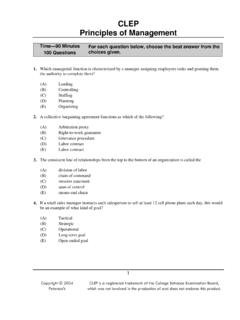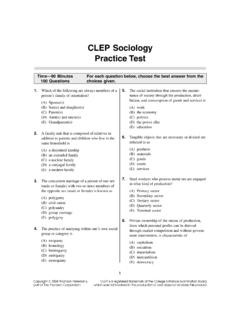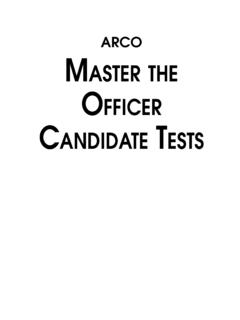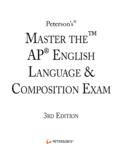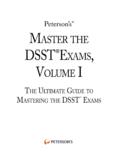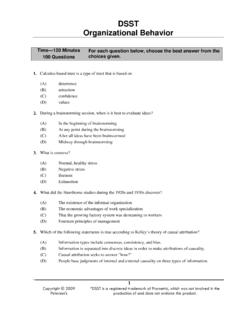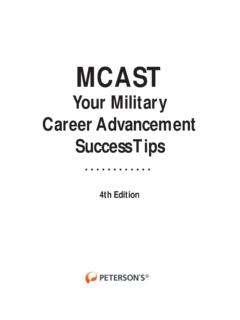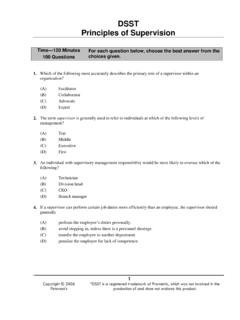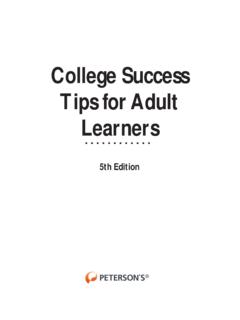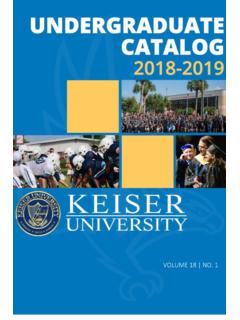Transcription of Answers and Explanations
1 clep is a registered trademark of the College Entrance Examination Board,which was not involved in the production of and does not endorse this educational psychology PRACTICE TESTA nswers and Explanations1. The correct answer is (E). In planning alesson a teacher needs to consider the develop-mental needs and unique individual characteristicsof the students. Furthermore, a teacher needs todevelop a lesson to meet the specific objectivesfor the unit and course, thereby serving to help thestudent move closer to the goals and objectivescontained in the school s mission The correct answer is (A). Correlationalresearch employs the systematic observation andrecording of data without manipulation of theobserved phenomenon or identification The correct answer is (D). Teaching is aninterpersonal, interactive process undertakenwith the purpose of eliciting or facilitatingspecific learning The correct answer is (B).
2 A skillfullycreative teacher would apply theory and researchto the practical everyday world of the classroomin order to produce effective The correct answer is (C). When testedwith systematic observation and valid researchmethods, some of the common sense approachesto teaching that appear to have face value oftenprove to be less effective than initially The correct answer is (C). Elaboration is aprocessing strategy that creates links betweennew information and information already storedin long term The correct answer is (A). Perception refersto the process of interpreting or giving meaningto an The correct answer is (A). The sensoryregister collects all incoming information for abrief period of time, even unconsciously pro-cessed sensation/information such as the circlesof light that flash across our eyes after a snap-shot is The correct answer is (A). Mathemageniceffects consider what students do to facilitatetheir own learning, noting especially theirorganizing and structuring The correct answer is (A).
3 Proceduralmemory is that which helps us recall particularskills or steps for accomplishing a The correct answer is (C). Storage, for thecognitive theorist, refers to the various pro-cesses that convert stimuli (encoding) into aform that can be retained in The correct answer is (C). The primacyeffect suggests that items that are listed first in aseries are often stored most readily in memory,whereas the recency effect would suggest thatthe most recent, and therefore the items last onlist, would be more readily The correct answer is (C). Semanticmemories are our memories for general factsand concepts. Most of what we learn in school(instructional content) is stored in our The correct answer is (C). Maintenancerehearsal is a process of keeping informationactive in short-term memory by repeating theinformation to , 12:11 PM1 Copyright 2004 Peterson'sCLEP is a registered trademark of the College Entrance Examination Board,which was not involved in the production of and does not endorse this educational psychology PRACTICE TEST15.
4 The correct answer is (E). The reticularactivating system is the midbrain s neurologicalsystem that alerts us to novel stimuli (in this casethe loud, sudden noise).16. The correct answer is (B). Of all the infor-mation received by our senses at any one mo-ment, that which becomes the focus of ourattention as novel, unique, or important will beprocessed from the sensory register to short-term(working) The correct answer is (D). Chunkinginformation is a processing strategy that groupsbits of information into more meaningful andeasily stored The correct answer is (E). Mnemonics arecognitive structuring memory devices whichfacilitate recall via chunking and, in this case, The correct answer is (A). Sometimespreviously retained information may interferewith the learning of new material (proactiveinterference/inhibition), or the learning of newmaterial may interfere with the memory ofpreviously retained information (retroactiveinterference/inhibition).
5 Interference or inhibi-tion is more likely when old and new materialsare very similar in The correct answer is (A). Episodicmemory is memory of specific times, places, orexperiences in this case, the details of a The correct answer is (E). The law of effectsuggests that any behavior followed by a pleas-ing effect will tend to be repeated; behaviorsfollowed by dissatisfying effects will tend to bediscontinued. This is the basis for the use ofreinforcement in operant The correct answer is (B). Extinction (inclassical conditioning) occurs when a previouslyconditioned stimulus (having been associatedwith an unconditioned stimulus) is presented inthe absence of the unconditioned stimulus andthus fails to continue to elicit the The correct Answer is (B). The Premackprinciple employs preferred or high frequencybehaviors as reinforcement for the performanceof a less preferred and thus lower The correct answer is (B).
6 Reinforcementcan be administered continuously (after each andevery correct response) or intermittently (afteronly select correct responses).25. The correct answer is (C). Reinforcement isdefined by what it does, not what it is. If itincreases the behavior that preceded it, then itcan be considered a The correct answer is (D). Behavioristsemphasize the role of the environment in stimu-lus association, contingency management, andobservational The correct answer is (C). Classical condi-tioning is stimulus association learning in whicha response to one stimulus is now elicited by anew, previously neutral stimulus. Feelinganxious when presented with a snake would mostlikely be an example of a classically conditionedemotional The correct answer is (B). Discriminationlearning occurs when one responds differently tosimilar stimuli, even in similar , 12:11 PM2 Copyright 2004 Peterson'sCLEP is a registered trademark of the College Entrance Examination Board,which was not involved in the production of and does not endorse this educational psychology PRACTICE TEST29.
7 The correct answer is (A). Negative rein-forcement occurs when a noxious stimuli isremoved following the performance of a desiredbehavior, resulting in increased frequency of The correct answer is (B). In an intermittentreinforcement schedule, the targeted behavior isreinforced some of the times, but not all thetimes it is performed. This form of reinforce-ment is resistant to The correct answer is (D). Intrinsic rein-forcement is that which is delivered internally(such as a sense of accomplishment or wellbeing), as opposed to extrinsic reinforcementthat is delivered externally (such as stickers,words of praise, or candy).32. The correct answer is (A). Centration is thetendency to focus on one perceptual aspect of anevent to the exclusion of others (size as opposedto amount, for example).33. The correct answer is (C). Vygotsky be-lieved that children s learning cannot take placein a vacuum; children learn by using ways ofacting and thinking provided by their culture,mastering tasks deemed to be culturally The correct answer is (B).
8 Assimilation wasPiaget s term for the process of making sense ofan experience or perception by fitting it intopreviously established cognitive structures(schemas).35. The correct answer is (D). A schema is amental network for organizing concepts andinformation; assimilation, accommodation,adaptation, and disequilibrium are all ways thatan existing schema might be temporarily orpermanently The correct answer is (D). Social learningtheory hypothesizes that a child s speech resultsfrom modeling, imitation, reinforcement, The correct answer is (A). Theorists gener-ally agree that development is typically orderly,occurring in predictable sequence (for examplemoving from open vowel to consonant sounds).38. The correct answer is (A). Piaget believedthat while biological readiness is important, it isthrough interaction with the physical environ-ment that the individual gains experience thatserves as the stimulus for The correct answer is (A).
9 A schema, forPiaget, was a mental network for organizingconcepts and The correct answer is (E). Transductivereasoning is a feature of the preoperational stageof development in which a child reasons neitherinductively nor deductively, but reasons insteadfrom particular to The correct answer is (D). Piaget theorizedthat when confronted with a new experience weare thrown into a state of cognitive disequilib-rium. We use the processes of assimilation andaccommodation to help us make sense of the newexperience and return us to a state of The correct answer is (D). Carol Gilliganfound that the moral decisions of females arebased on the ethics of The correct answer is (C). Kohlberg s stageof moral development called interpersonal-concordance, or harmony, is when moral/ethicaldecisions are based on what pleases, helps, or isapproved by , 12:11 PM3 Copyright 2004 Peterson'sCLEP is a registered trademark of the College Entrance Examination Board,which was not involved in the production of and does not endorse this educational psychology PRACTICE TEST44.
10 The correct answer is (E). Anorexianervosa, or anorexia, is an eating disorder ofself-imposed starvation and refusal to The correct answer is (D). The personalfable refers to David Elkind s concept thatadolescents often create and operate from self-generated, often romanticized stories of theirpersonal The correct answer is (D). In Kohlberg spre-conventional stage of morality, children sethics are based not on rules but rather onconsequences of The correct answer is (E). The drive to excelis most frequently referred to as the achievementneed, or achievement The correct answer is (B). Students with aninternal locus of control look to self attributes,such as ability or effort, to explain success orfailure on The correct answer is (D). Maslow believedthat human needs exist in a hierarchy in terms ofthose needed for survival taking precedence overmore growth-oriented needs. When both lowerand higher needs are aroused, we are directed tosatisfy the lower, more survival-based The correct answer is (C).

